
What does your home smell like? Maybe it smells like the food you cook, the cleaning products you use, or the paints and varnishes from your home projects. Or perhaps you aren’t aware of your home’s scent as you’ve become accustomed to it.
Indoor air is comprised of several things including dust, microbials, and gases, but largely of VOC’s (volatile organic compounds). VOCs can be detected by smell, while others are completely odorless. Each indoor environment contains a unique assortment of VOCs, and one technique for analyzing these compounds is solid phase extraction (SPE) and gas chromatography.
In this experiment, we set out to perform VOC analysis in indoor air using our Frontier EGA/PY-3030D multi-shot pyrolyzer. To perform VOC analysis by way of solid phase extraction (SPE), we also needed to employ Frontier Magic Chemisorbers. Magic Chemisorbers are reusable solid phase extraction elements coated in non-polar (PDMS) or polar (PEG) phases, which provide a surface for volatiles to adsorb unto.
A Magic Chemisorber is placed in a closed vial with a sample, or immersed in a liquid for a period of time. Volatiles from the sample that are adsorbed onto the Chemisorbers are then extracted in the pyrolyzer using a thermal desorption step.
As an example, we placed the wick from an essential oil air freshener inside a vial with a PDMS Chemisorber. After a GC run, we found that most of the volatiles released by the air freshener were terpenes of various scents.
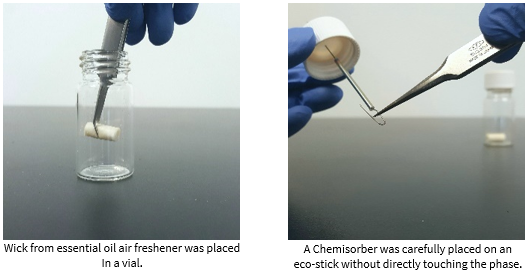
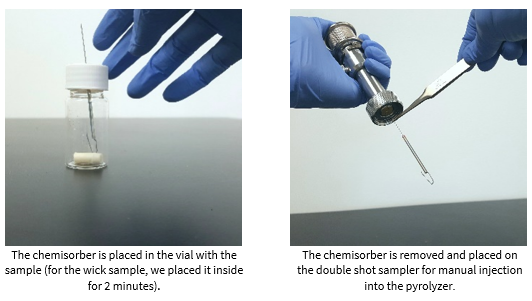
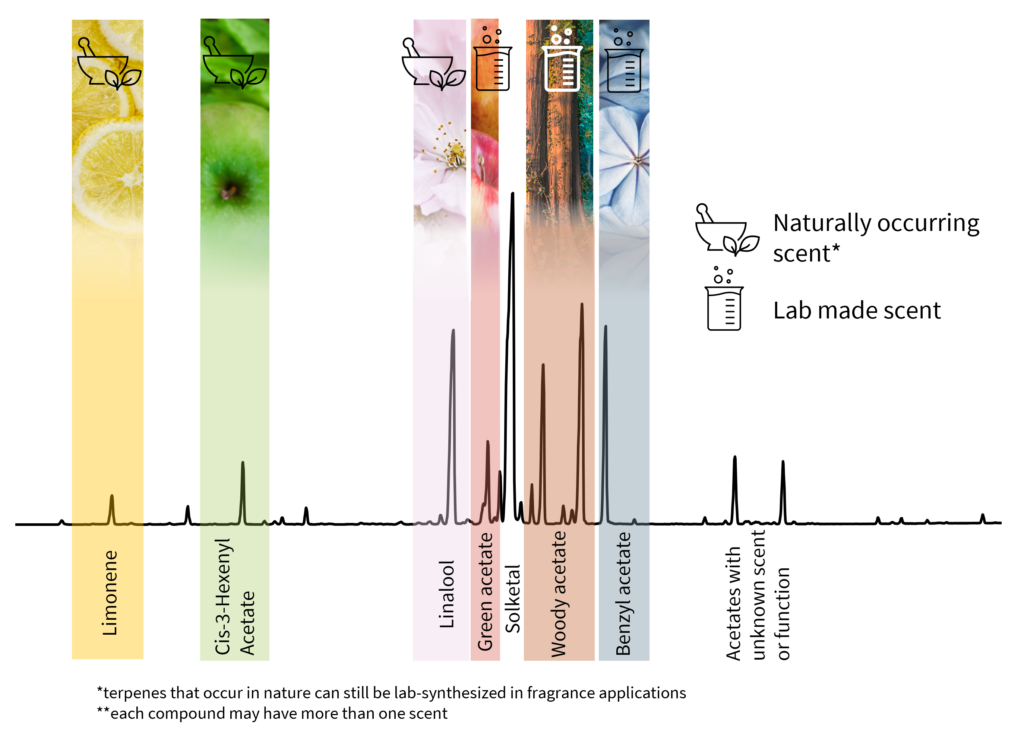
Some of the compounds had floral notes, some were fruity, and one had a woodsy aroma. These terpenes collectively form the overall fragrance of the air freshener, which begs the question: What exactly was this air freshener’s smell?
According to the label, it was called “Fresh Linen”.
To take our Magic Chemisorber experiments to a new level, we expanded our “headspace volume” from a single vial to an entire house – two houses in fact. Both were newly built; one was lived in for two years by a single occupant, and the other was only a few months old with no occupant history. For this experiment, we opted to use the Magic Chemisorber L500. This solid phase extraction devices are ideal for trace analysis. We placed them inside the living rooms and bedrooms of our test homes for two days.
The Fresh Linen air freshener we ran was the same one plugged inside our occupied test home. Although we did find the specific mix of terpenes from the Fresh Linen plug-in, this home also contained foreign compounds, such as alkanes and alcohols.
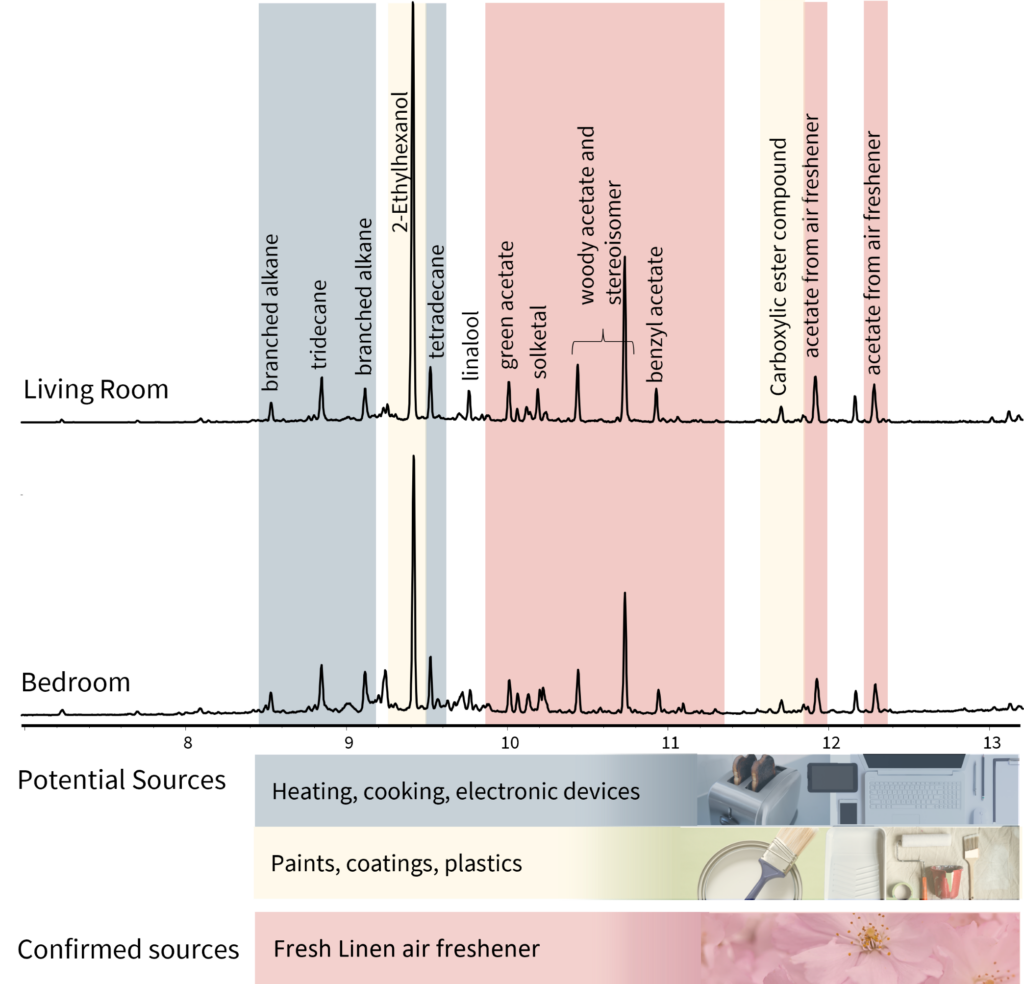
Branched and linear alkanes can come from activities like cooking, or be emitted from electronic equipment or consumer products. Our occupied home also contained a significant amount of 2-Ethylhexanol. This compound is a well-studied environmental concern that poses as a respiratory irritant. There are numerous sources of 2-Ethylhexanol, including plants, plastics and solvents to name a few. The most interesting source of 2-Ethylhexanol is a plasticizer added to PVC called DEHP. Over time, as microbials enter and move about an indoor space, they can break down plastics and plasticizers, which lead to volatiles like 2-Ethylhexanol. Although this may not be the only way of phthalate decomposition, time and occupancy certainly influence the VOCs accumulated in air.
A common source of PVC/DEHP is vinyl wood flooring. Both test homes contained vinyl wood flooring in the common rooms and carpet in the bedrooms. Although we did not cut out a test sample from the occupied home (not even a microgram!), we did test a representative sample of the flooring in our new home. We also tested a collection of laminate and vinyl wood floors of various brands by direct thermal desorption of microgram amounts of each sample. The result? We found DEHP in most of these floorings, including the one from the new home.
Does this mean we also found 2-Ethylhexanol in our new home? Yes, but in small amounts. The newly built home was only a few months old, and at the cusp moving in. One VOC of concern for the homeowners was an ingredient in paint. This carboxylic ester is part of a coalescent in latex paints used to seal and protect walls from moisture and mold. (Interesting to note, this compound was also found in the air of our lived-in home). Although we did find trace 2-Ethylhexanol in both the flooring and paint of the new test home.
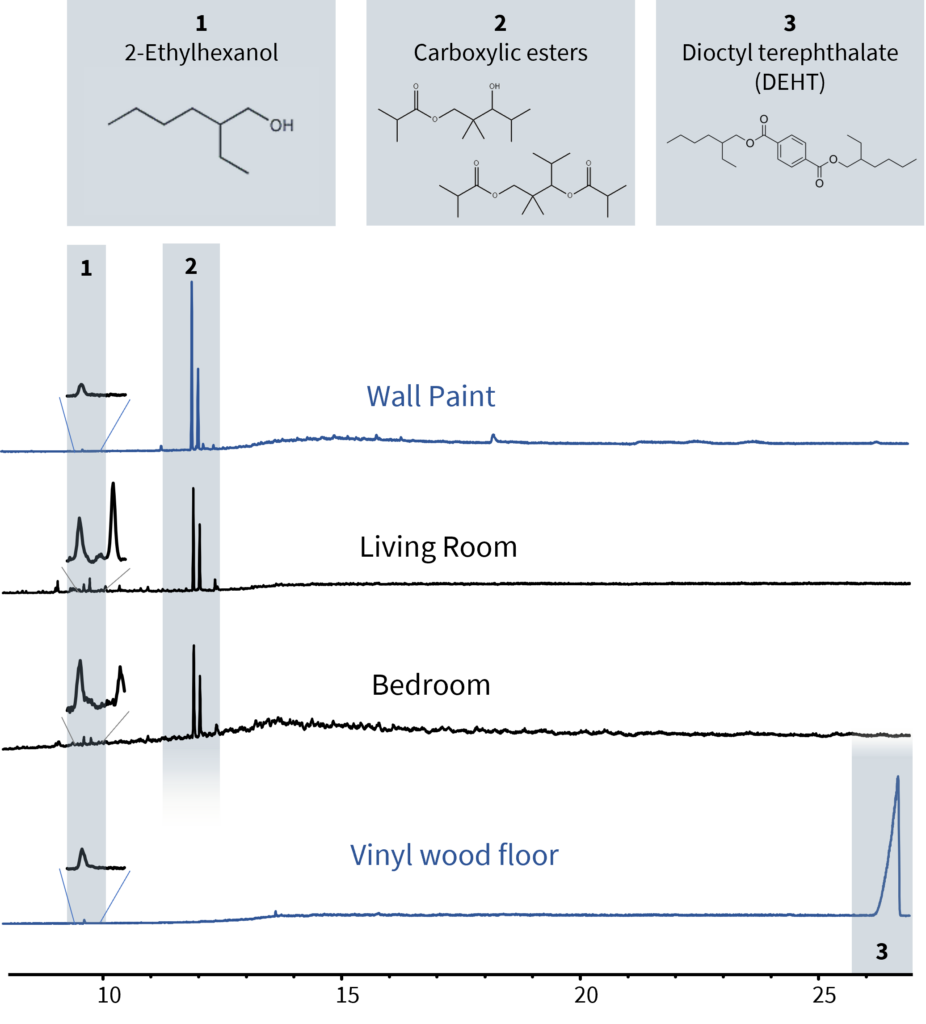
It’s a fair question. Especially since the Frontier pyrolyzer can thermally break off volatiles from the sample itself without using SPEs. However, thermal desorption is still a direct thermal intervention on the sample. This may not mimic the natural conditions we may want to study. Clearly it isn’t feasible for a house to heat to 230 °C in real life (in a controlled-manner!). But that doesn’t stop a chemist in the lab from wanting to understand what volatiles a sample gives off as it sits in atmosphere.
In the example of our homes, we found phthalates by direct thermal desorption of a piece of flooring. By way of the Chemisorbers, we can see that the phthalates themselves were not in the air, but rather the breakdown chemicals of the phthalates.
It’s also worth noting that the Magic Chemisorbers are self-cleaning, which makes them an especially handy tool to keep in the lab. High boiling components that are not thermally desorbed can be easily removed by immersing in a solvent such as hexane. This flexibility makes them an easy accessory to reach for when there is a need to quickly test VOCs in a vial.
As we suspected from what we know about VOCs, the experiment showed that the occupied home contained elements unique to the occupant (like the air freshener down to its specific smells) and from the home itself (the possible plastic/ plasticizer breakdown). The new home, with its empty rooms, fresh coat of drying paint and brand-new floors, waits for its new occupants and their belongings before its VOC make-up fully takes shape.
For our experiments, the Magic Chemisorber did a great job of showing a closer view into the air quality of our test homes.
Complete this form below to sign up and we will reach out to you with instructions
